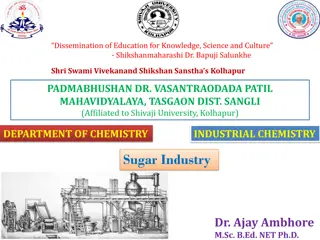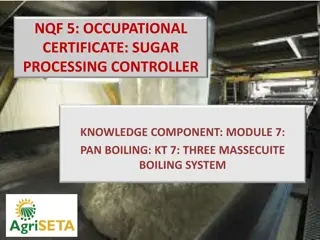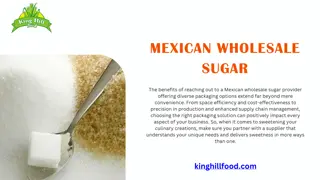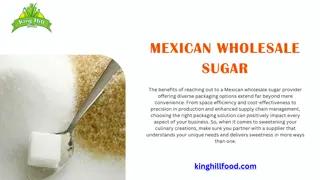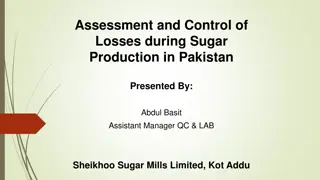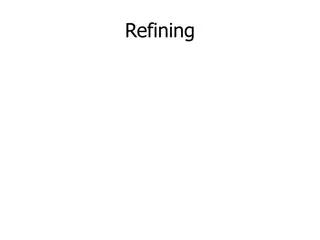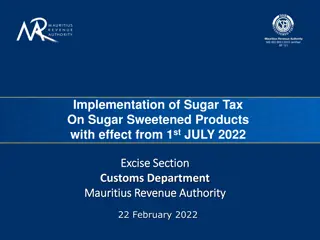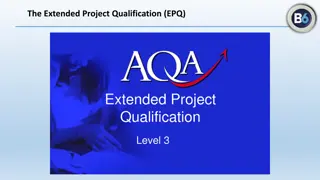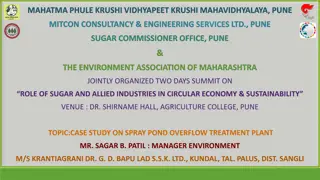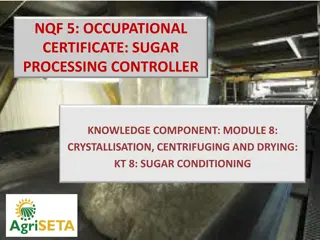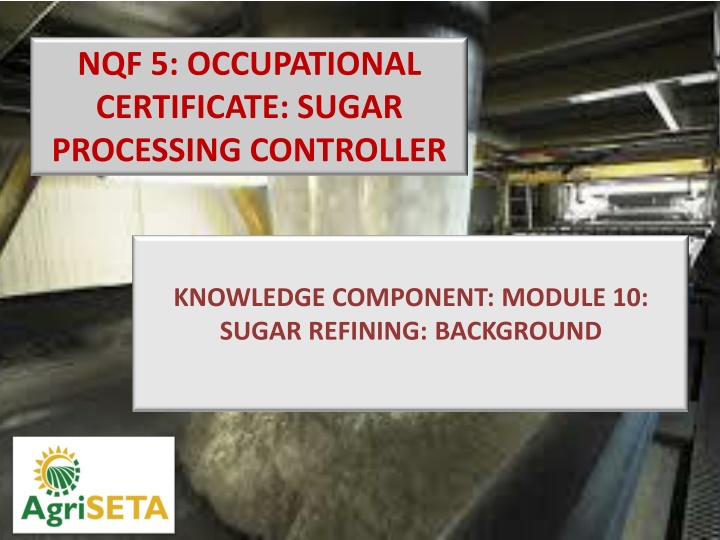
Insight into Sugar Refining Process
Explore the purpose and overview of the sugar refining process, including details on clarifying melt, crystallization techniques, and color removal methods used in the refinery. Learn about the importance of removing impurities from sugar crystals to produce high-quality refined sugar.
Download Presentation

Please find below an Image/Link to download the presentation.
The content on the website is provided AS IS for your information and personal use only. It may not be sold, licensed, or shared on other websites without obtaining consent from the author. If you encounter any issues during the download, it is possible that the publisher has removed the file from their server.
You are allowed to download the files provided on this website for personal or commercial use, subject to the condition that they are used lawfully. All files are the property of their respective owners.
The content on the website is provided AS IS for your information and personal use only. It may not be sold, licensed, or shared on other websites without obtaining consent from the author.
E N D
Presentation Transcript
NQF 5: OCCUPATIONAL CERTIFICATE: SUGAR PROCESSING CONTROLLER KNOWLEDGE COMPONENT: MODULE 10: SUGAR REFINING: BACKGROUND
Purpose of the Refinery Very high pol (VHP) sugar, as produced by a raw sugar mill, has a pol of over 99.3% and moisture of 0.15%. This gives a brix of 99.85% (100 0.15) and hence a non-pol content of 0.55% (brix pol). This non-pol represents impurities in the VHP sugar. The purpose of the refinery is to remove impurities from sugar crystals. The refinery, whether it is attached to a raw sugar mill (a backend refinery), or whether it stands separately as a central refinery, accepts VHP sugar as its raw material.
Overview of Refinery Process The sugar is dissolved (melted) and the melt is processed similarly to mixed juice in the boiling house. Melt purity, however, is over 99% and what is measured in refinery products are impurities, in the form of units of colour. Melt colour is removed by various clarification processes. The clarified melt is evaporated and up to 4 crops of crystals are boiled from this. These crystals are combined to form commercial refined sugar. The resultant final molasses may be boiled to produce more crystals that will be re-melted, may be recycled to rawhouse syrup (in backend refineries) or may be used as a by-product.
Overview of Refinery Process (cont.) Re-crystallisation (from a higher purity mother liquor) is alone responsible for a considerable amount of colour removal but other techniques must be employed to obtain the low colour of white sugar. Supersaturation coefficients are very difficult to control in refinery boiling because the zones of supersaturation are narrow and the crystal growth rate is extremely rapid. Grain formation is done by shocking the pan into spontaneous grain formation just before (it is hoped) the labile zone is reached. This is achieved by introducing powdered sugar, sugar slurry, or sugar dust into the pan.
Overview of Refinery Process (cont.) In rawhouse clarification, a sponge of tri- calcium phosphate is formed in the juice (at 10% brix) and this sponge is settled. Melt clarification, however, takes place at 65% brix. The resultant precipitate is made to form a cake on the cloth of a special filter and the whole liquor is forced through this cake. This optimises solids removal and decolourisation.
Overview of Refinery Process (cont.) When the mat becomes too thick to allow easy passage of liquor through it, it has to be de-sweetened. This is done by running water (rather than more melt) through the filter. The resultant sweetwater is used for duties like re- melting. The de-sweetened precipitate is diluted and filtered again before being discarded. Some processes use flotation clarification. The treated melt is aerated and the precipitate rises in the form of a scum that is skimmed off the surface.
Main steps in refining Affination: The molasses film around the crystal is washed off using a saturated sugar solution. The sugar is then centrifuged. All S.A. refineries receive VHP sugars and do not need to employ this step. Melting: The crystal is dissolved in water. Colour removal. Clarification similar to rawhouse work (carbonatation, sulphitation or phosphatation) is carried out, or special processes using ion exchange resins or granular carbon are employed.
Main steps in refining (cont.) Evaporation: The fine liquor (after decolourisation) is concentrated to near saturation. Crystallisation: Crystals are boiled in vacuum pans, similar to the procedure in rawhouse work. Centrifugation: Batch centrifugals separate crystals from the molasses (called jet, green or run-off in refining).
Main steps in refining (cont.) Drying and conditioning: Drying expels surface moisture, while conditioning, a much longer process, expels moisture bound on (and possibly within) the crystal. Packaging. Exhaustion of run-off: Run-off is boiled in as many steps as is required to maximise sucrose recovery.
Sugar Specifications Parameter Refined sugar - <0.06 - <0.02 <0.03 <80 <110 Brown sugar - - < 0.23 - - - - VHP sugar for export >99.30 <0.18 - - <0.20 <1350 - Pol S Moisture% Safety factor Reducing sugars% Conductivity ash% ICUMSA 420 colour Unfiltered 420 colour Starch ppm Fines % SO, ppm <150 <30 - - - - - - <25


